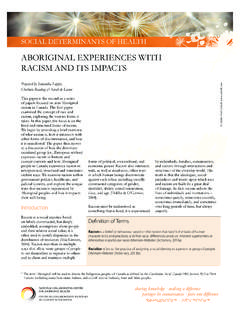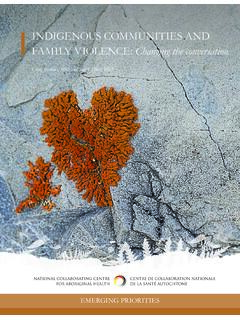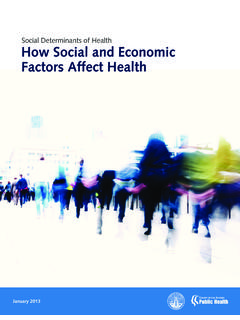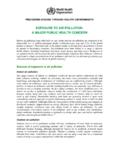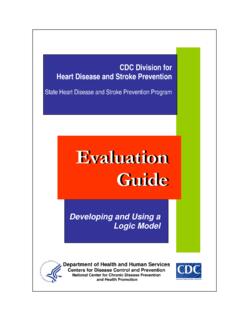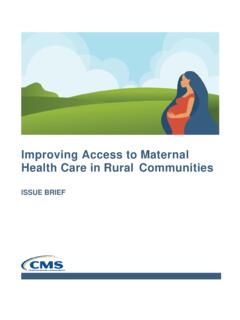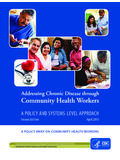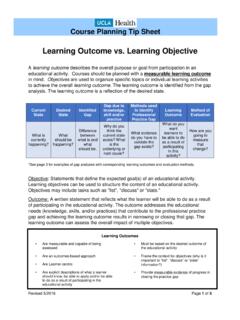Transcription of An Overview of Aboriginal Health in Canada
1 Significant Health disparities exist between Aboriginal and non- Aboriginal Canadians. The factors that underlie these Health disparities and hinder our ability to address them are multi-faceted. This fact sheet provides a general introduction to Aboriginal Health in Canada and to the broad context in which Aboriginal communities, Health practitioners, policy-makers and researchers seek to improve the Health and well-being of Aboriginal peoples. Specifically, it provides an Overview of Aboriginal peoples, the social determinants that impact their Health , current Health status indicators, and the jurisdictional framework for Aboriginal Health policies and programs. Who Are Aboriginal Peoples in Canada ? Aboriginal peoples collectively refers to the original inhabitants of Canada and their descendants, including First Nations, Inuit, and M tis peoples, as defined in Section 35(2) of the Canadian Constitution Act, 1982.
2 According to Statistics Canada s National Household Sur vey (NHS),1 in 2011 there were 1,400,685 people in Canada who self-identified as Aboriginal , representing of Canada s total population (Statistics Canada , 2013a).First NationsFirst Nations peoples are original inhabitants of the area now known as An Overview Of AbOr iginAl Health in Canada Setting tHe COnteXt1 The 2011 National Household Survey (NHS) replaced the 2006 long-form census and has raised concerns for quality and comparability over time (Sheikh, 2013). Statistics Canada has identified potential limitations to the NHS data due to incomplete enumeration of 36 Indian reserves and low response rates among certain populations (Statistics Canada , 2013b). Due to the limited data available from the 2011 NHS, this fact sheet relies heavily on data obtained from the 2006 Canadian knowledge making a difference partager les connaissances faire une diff rence2 Canada .
3 Within this population there exist many distinct cultural groups or nations, including 630 distinct communities (Assembly of First Nations, ) and approximately 60 different languages (Statistics Canada , 2013a). Based on the 2011 National Household Survey, there are an estimated 851,560 First Nations people living in Canada . About 49% of First Nations people reported living on-reserves, while 51% live off-reserve. The majority (approximately 75%) of First Nations people residing off-reserve live in urban areas (Statistics Canada , 2008). InuitInuit peoples are original inhabitants of the Arctic regions of the area now known as Canada . The majority of the 59,445 Inuit people in Canada live in their traditional territories in four regions collectively known as Inuit Nunangat (Statistics Canada , 2013a). These regions are: Nunatsiavut (Labrador), Nunavik (northern Quebec), Nunavut, and the Inuvialut Settlement Region in the Northwest Territories (Inuit Tapiritt Kanatami, ).
4 Close to 70% of the Inuit people speak Inuktitut, although the number of people reporting it as their first language is declining (Statistics Canada , 2008).M tisIn French, the word M tis translates as mixed. There exists some debate over who is considered M tis, with some taking a broader definition than outlined by the M tis National Council (MNC). The MNC defines M tis people as individuals who self-identify as M tis, are of historic M tis origin (mixed First Nations and European heritage, descendants primarily of 18th century fur traders and First Nations in the area known as the M tis Homeland), and are recognized by the M tis Nation (M tis National Council, ). M tis people have a distinct culture, traditions and language (Michif ) which contribute to their collective consciousness and nationhood (ibid). The 2011 National Household Survey reports that there are approximately 451,795 M tis people in Canada (Statistics Canada , 2013a).
5 Non-Status and Urban Aboriginal PeoplesMany people who self-identify as Aboriginal are not registered under Canada s 1876 Indian Act, which defines who is considered a status Indian and thus eligible for a range of programs and services offered by federal and provincial agencies. People who identify as First Nations but who are not a Registered Indian according to the federal government are considered non-status. Based on the 2011 National Household Survey, Statistics Canada reported that there were 213,900 First Nations people who were not Registered Indians in Canada , representing of the total Aboriginal population (Statistics Canada , 2013a). Three-quarters of this population reside in urban areas, with the largest numbers in metro Toronto, Vancouver, Montreal, Ottawa-Gatineau and Edmonton, respectively (Indian and Northern Affairs, 2009).
6 The Daniels DecisionIn early 2013, the Federal Court of Canada ruled in a decision known as the Daniels Decision that M tis and non-status Indian peoples be considered Indians under section 91(24) of the Canadian Constitution Act, 1867 (CBC News, 2013). Although the full implications of the Daniels Decision are not yet clear, this decision potentially doubles the number of people considered status Indians under the 1876 Indian Act. The federal government appealed the decision and is unlikely to implement it while the case is under appeal, a process that could take several Overview of Aboriginal Health in CanadaDeterminants of HealthHealth is determined by many different factors affecting individuals, communities and populations. Health research focused on Aboriginal populations in Canada shows that Health disparities are directly and indirectly associated with or related to social, economic, cultural and political inequities; the end result of which is a disproportionate burden of ill Health and social suffering on the Aboriginal populations of Canada (Adelson, 2005, p.)
7 S45).The social, economic, cultural and political inequities that impact the Health of individuals and communities are often referred to as social determinants of Health . 2 It is important to acknowledge there are differences in the socio-economic circumstances and lived world experiences of First Nations, Inuit, and M tis peoples, between status and non-status, on-reserve and off-reserve, as well as urban and rural Aboriginal populations. Nevertheless, several decades of census data and other research show a persistent gap in socio- Aboriginal Health in CanadaPrior to European contact, Indigenous peoples of Canada had fully functional systems of Health knowledge that were practiced within the contexts of their specific ways of knowing and being. However, the diseases and conflicts of colonization devastated Indigenous populations and their systems of Indigenous Health knowledge.
8 Although the Health of Aboriginal populations in Canada has been improving in recent years, First Nations, Inuit, and M tis peoples continue to experience considerably lower Health outcomes than non- Aboriginal Canadians. On many Health indicators, First Nations, Inuit, and M tis peoples continue to show a disproportionate burden of disease or Health disparities. These disparities are often rooted in Health inequities, which are the underlying causes of the disparities, many if not most of which sit largely outside the typically constituted domain of Health (Adelson, 2005, p. S45). These are referred to as determinants of For more information on how social determinants can impact Health , please refer to the NCCAH s Social Determinants of Health fact sheets, which can be found at and Wilkinson, R. and M. Marmot, eds.
9 (1998). Social Determinants of Health : The Solid Facts. Copenhagen: World Health Limitations in Aboriginal Public HealthPublic Health assessments and interventions, including those targeting Aboriginal populations, depend on complete and accurate statistical information about the Health and well-being of groups of people in order to be effective. Unfortunately, in Canada there exists a serious deficit in the availability of accurate, complete, and up-to-date statistical information about the Health of certain sub-populations of First Nations, Inuit, and M tis peoples (Smylie, 2010). Many Aboriginal Health data initiatives, for example, have not collected data on non-registered First Nations people, or on M tis or Inuit people living in urban areas (Ibid.). Further, inconsistencies in First Nations, Inuit, and M tis ethnic identifiers in provincial Health data collected through vital registration systems, hospital administrative datasets, and acute and chronic disease surveillance systems means that these populations are often invisible in Health statistics (Ibid.)
10 Although work is underway to improve data regarding the Health of First Nations, Inuit, and M tis populations, these initiatives are isolated. The lack of statistical information in this fact sheet is a reflection of the limited availability of complete, accurate, and up-to-date data on Aboriginal Health that is disaggregated by sub-population and geographical status and well-being between Aboriginal and non- Aboriginal people in Canada (Reading & Wien, 2009).4in Canada but also around the world (Gracey & King, 2009; King, Smith, & Gracey, 2009). In Canada and elsewhere, Indigenous peoples are affected by major Health problems at rates much higher than non-Indigenous populations. These Health issues include high infant and young child mortality; high maternal morbidity and mortality; heavy infectious disease burdens; malnutrition and stunted growth; shortened life expectancy; diseases and death associated with cigarette smoking ; social problems, illnesses and deaths linked to misuse of alcohol and other drugs; accidents, poisonings, interpersonal violence, homicide and suicide; obesity, diabetes, hypertension, cardiovascular, and chronic renal disease (lifestyle diseases); and diseases caused by environmental contamination (for example, heavy metals, industrial gases and effluent wastes) (ibid).




